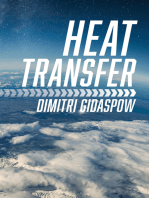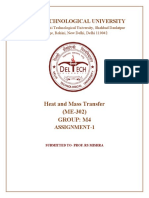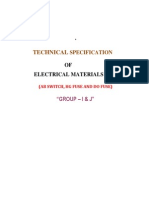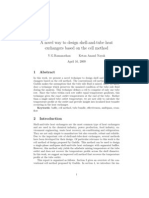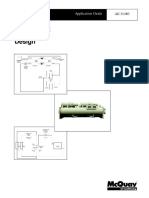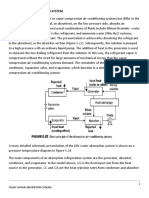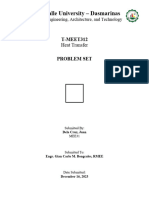Thermal Analysis of Electrical Machines Limits and Heat Transfer Principles
Thermal Analysis of Electrical Machines Limits and Heat Transfer Principles
Uploaded by
Anonymous sAmJfcVCopyright:
Available Formats
Thermal Analysis of Electrical Machines Limits and Heat Transfer Principles
Thermal Analysis of Electrical Machines Limits and Heat Transfer Principles
Uploaded by
Anonymous sAmJfcVOriginal Description:
Copyright
Available Formats
Share this document
Did you find this document useful?
Is this content inappropriate?
Copyright:
Available Formats
Thermal Analysis of Electrical Machines Limits and Heat Transfer Principles
Thermal Analysis of Electrical Machines Limits and Heat Transfer Principles
Uploaded by
Anonymous sAmJfcVCopyright:
Available Formats
Power Engineering Briefing Note Series
http://www.eleceng.adelaide.edu.au/research/power/pebn/
Thermal Analysis of Electrical Machines :
Limits and Heat Transfer Principles
PEBN #3 (10 May 2008)
W.L. Soong
School of Electrical and Electronic Engineering
University of Adelaide, Australia
soong@ieee.org
Abstract this brief gives an overview of the thermal analysis of
electrical machines. The key thermal limitations in electrical
machines are often winding insulation life and demagnetisation
of the permanent magnets. The three key heat transfer
principles (conduction, convection and radiation) are introduced
drawing largely from Ref [2].
II. HEAT TRANSFER BY CONDUCTION
A. Conduction Principles
In AC electrical machines, heat transfer by conduction is the
main method by which power losses from the conductors are
transferred to the outside of the machine. The heat flux is
given by [2] :
dT
T
=k
W/m 2
k
(1)
dx
t
where dT/dx is the rate of change of temperature with position,
T is the temperature difference across the material, t is the
thickness of the material and k is the thermal conductivity of
material in W/(m.K).
Typical values for the thermal
conductivity of common materials is given in Table 3.
TABLE 3. TYPICAL THERMAL CONDUCTIVITY VALUES [1,4]
I. THERMAL LIMITING FACTORS
Material
air @ 25oC
stator coils (typical)
Nomex slot liner
epoxy (unfilled)
insulation (typ)
epoxy (silica filled)
thermal epoxy
lamination material
steel
copper
A. Winding Insulation
The temperature capability of insulation materials used in
electrical machines is grouped in classes as shown in Table 1.
TABLE 1. COMMON INSULATION CLASSES [1]
Class
Class A
Class B
Class F
Class H
Maximum Operating Temperature
105oC
130oC
155oC
180oC
Thermal Conductivity
0.025 W/(m.K)
0.06 0.09 [3]
0.13
0.19
0.2
0.3
14
20 46
50
385
B. Conduction Analysis Example : Slot Temperature Rise
The insulation on copper windings is very sensitive to over
temperature operation.
The Arrhenius law states that
insulation life expectancy roughly halves for every 10oC rise
in temperature. For example consider a class F insulation
(155oC) with an expected life of 20,000 hrs. If this is operated
at 175oC temperature, which is 20oC above its design value,
then its expected life is one quarter of its design value, that is
5,000 hrs. Note if the material is operated at 135oC, that is
20oC below design value, its expected life will be 80,000 hrs.
What is an acceptable current density J (A/mm2) for
electrical machines? Consider a deep parallel-sided slot as
shown in Fig. 1, so that the heat flow can be assumed to be
one-dimensional in a horizontal direction.
coil
iron
B. Permanent Magnets
heat flux
The magnetic properties of permanent magnets (PM) are
temperature dependent and limit their allowable operating
temperature range.
position
TABLE 2. SINTERED PERMANENT MAGNET PROPERTIES [2]
Property
Curie Temperature
Max. Working Temp.
Temp. Co-efficient of
BR
Ferrite
450oC
250oC
-0.2%/oC
NdFeB
310-350oC
80-200oC
-0.08%/oC to
-0.15%/oC
SmCo
700-800oC
250-350oC
-0.045%/oC to
-0.08%/oC
temp rise
-wS/2
The Curie temperature is the temperature at which the PM
irreversibly loses magnetization and represents the ultimate
temperature limit. A more practical limit is the maximum
working temperature shown.
The remanent flux density BR for PM materials falls as the
temperature increases. This means that for PM machines
designed for high temperature operation, there can be a
significant difference between the back-emf at room
temperature and operating temperature. This decrease in the
remanent flux density also makes the machine more prone to
demagnetisation when high stator winding currents are present
and so this needs to be checked at the maximum expected
operating temperature.
pebn rv1.2.doc
position
0
wS/2
Fig. 1. Simplified thermal analysis of heat conduction through a deep,
parallel-sided slot showing the parabolic temperature distribution.
The heat flux increases linearly with the distance from the
centre of the slot. This results in a parabolic temperature
distribution with a peak value :
Tm =
pf J 2 ws2
8k
(2)
where :
pf : fraction of slot area which is copper (typically 30%)
: resistivity of conductor, for instance 2.36 10-8 .m at
120oC for copper
Page 19
24-Jul-08
Power Engineering Briefing Note Series
http://www.eleceng.adelaide.edu.au/research/power/pebn/
Allowable Current Density J [A/mm2]
J : is the current density in A/m2
k : thermal conductivity of the composite of the conductor,
air, insulation and varnish in the slot;
wS : is the width of the slot
Fig. 2 assumes a slot conductivity of 0.075 W/(mK) which
is typical for commercial induction machines [3]. The
allowable current density falls inversely with coil width. For
wide slots the allowable current density is very low. Hence
for large machines (e.g. power station generators) it is
necessary to pass coolant directly through the conductors to
achieve reasonable values of current density.
16
Assumptions
k = 0.075 W/(mK)
pf = 0.3
T = 75degC
= 2.36e-8 m (120degC)
no slot liner
14
12
10
values are about five times the natural convection co-efficient.
It can be roughly estimated as [2] :
h 3.95
The heat flux associated with electromagnetic radiation is
given by [2] :
= Th4 Ta4
4
2
0
10
15
20
25
30
35
Coil Width [mm]
Fig. 2. Maximum allowable conductor current density as a function of coil
width for a typical range of assumptions listed in the figure.
(6)
A. Natural Convection
The heat transfer co-efficient for natural convection around
an un-finned cylindrical motor of diameter D which is
mounted horizontally is approximately given by [2] :
0.25
T
(4)
h 1.324
W/m 2 /K
For instance for a 0.1 m diameter motor with a temperature
rise of 40oC, then h 5.9 W/m2/K and so from (3) the heat
flux is = 237 W/m2.
Ref. [5] gives typical values of heat transfer co-efficient for
natural convection as 2 25 W/m2/K for gases and 50 1000
W/m2/K for liquids.
which is comparable to that obtained by natural convection.
V. ROUGH RULES OF THUMB
(3)
where T is the difference in temperature between the cooling
medium and the hot surface and h is the heat transfer coefficient which depends on the properties of the fluid and its
velocity. There are two types of convection : natural
convection where fluid circulation is purely due to natural
movement of the fluid associated with thermal gradients while
forced convection is where the fluid circulation is driven by an
external fan, blower or pump.
Ref. [2] gives some rough rules of thumb as follows for the
maximum heat flux obtainable with a 40oC rise as roughly :
800 W/m2 for natural convection and radiation;
3,000 W/m2 for forced convection;
6,000 W/m2 for direct liquid cooling.
VI. REFERENCES
[1] E.S. Hamdi, Design of Small Electrical Machines, Wiley, 1994.
[2] J.R. Hendershot and T.J.E. Miller, Design of Brushless PermanentMagnet Motors, Magna Physics Publishing and Clarendon Press, 1994.
[3] D. Staton, A. Boglietti and A. Cavagnino, Solving the More Difficult
Aspects of Electric Motor Thermal Analysis in Small and Medium Size
Industrial Induction Motors, IEEE Transaction on Energy Conversion,
Vol. 20, Issue 3, Sept. 2005, pp. 620 628.
[4] http://en.wikipedia.org/wiki/Thermal_conductivity (accessed 10 May,
2008)
[5] F.P. Incropera and D.P. DeWitt, Introduction to Heat Transfer, Wiley,
1990.
B. Forced Convection
Blowing air over the motor increases the heat transfer coefficient by the square root of the air velocity and typical
pebn rv1.2.doc
W/m 2
= 0.9 5.67 108 [ 60 + 273] [ 20 + 273] = 251 W/m 2
The heat transfer by convection is given by Newtons Law of
Cooling [2] :
W/m 2
is emissivity (1 for an ideal black body), a value of 0.9 is
more reasonable for a black-painted surface
= Stefan-Boltzmanns constant 5.67 x 10-8 W/(m2K4)
Th = temperature of hot object (K)
Ta = temperature of surroundings (K)
For example consider a temperature rise of 40oC above an
ambient of 20oC and a 0.9 value for emissivity, then the heat
flux is :
III. CONVECTION
= h T
(5)
IV. RADIATION
W/m 2 /K
For instance for an air velocity of 4 m/s blowing over a motor
which is 0.1 m long (5) gives a value of h 25 W/m2/K which
is roughly four times that for natural convection. For a 40oC
temperature difference this gives a heat flux of = 1000
W/m2.
Ref. [5] gives typical values of heat transfer co-efficient for
forced convection as 25 250 W/m2/K for gases and 50
20,000 W/m2/K for liquids.
v
L
Page 20
A WORD FOR TODAY
These are the words of the Amen, the faithful and true
witness, the ruler of God's creation. I know your deeds,
that you are neither cold nor hot. I wish you were either
one or the other! So, because you are lukewarmneither
hot nor coldI am about to spit you out of my mouth.
Revelation 3:14-16 (NIV)
24-Jul-08
You might also like
- SolidWorks API Series 1 - Programming & Automation PDFDocument268 pagesSolidWorks API Series 1 - Programming & Automation PDFAnonymous sAmJfcV86% (7)
- Thermoelectric Cooling Systems Design GuideDocument21 pagesThermoelectric Cooling Systems Design GuideCMPENo ratings yet
- Solution of Transient 2D Heat Conduction Problem Using Freefem++Document4 pagesSolution of Transient 2D Heat Conduction Problem Using Freefem++Chicca PantanoNo ratings yet
- Steady State Temperature Distribution of Cast Resin Dry Type Transformer Based On New Thermal Model Using Finite Element MethodDocument5 pagesSteady State Temperature Distribution of Cast Resin Dry Type Transformer Based On New Thermal Model Using Finite Element MethodAnonymous sAmJfcVNo ratings yet
- ME3122 Tutorial 1 - ConductionDocument2 pagesME3122 Tutorial 1 - ConductionUnknown uploaderNo ratings yet
- Mech302-Heat Transfer Homework-7 SolutionsDocument8 pagesMech302-Heat Transfer Homework-7 SolutionsJake OkuyeNo ratings yet
- Very ImportantDocument6 pagesVery Importantmonuaadi2003No ratings yet
- Question BankDocument5 pagesQuestion BankkshitijsdiwakarNo ratings yet
- G4 - Sample ExamsDocument8 pagesG4 - Sample ExamsLeeSM JacobNo ratings yet
- 4363 112 Heat TransferDocument6 pages4363 112 Heat Transferyogesh_b_kNo ratings yet
- An Alternative Cooling Arrangement For The End Region of ADocument5 pagesAn Alternative Cooling Arrangement For The End Region of AVitthal KhandagaleNo ratings yet
- R07 Set No. 2Document8 pagesR07 Set No. 2bhaskar5377No ratings yet
- Heat TransferDocument2 pagesHeat TransferDL 26PankajNo ratings yet
- Temperature Rise Estimations in Rogers High Frequency Circuit Boards Carrying Direct or RF CurrentDocument2 pagesTemperature Rise Estimations in Rogers High Frequency Circuit Boards Carrying Direct or RF Currentrahul05singhaNo ratings yet
- Tutorial SheetDocument5 pagesTutorial Sheetpradeep.kumarNo ratings yet
- Optimal Design of A High Power High Frequency TransformerDocument10 pagesOptimal Design of A High Power High Frequency TransformerPablo KuziwNo ratings yet
- Heat TransferDocument3 pagesHeat TransferDL 26PankajNo ratings yet
- Tutorial 2Document3 pagesTutorial 2Yik Vui KongNo ratings yet
- Optimizing Dimension of Heat Sinks Plate db461907Document5 pagesOptimizing Dimension of Heat Sinks Plate db461907Al Hussein CoulibalyNo ratings yet
- Model Exam.2.2Document3 pagesModel Exam.2.2Srinivasan PichandiNo ratings yet
- 07a40801 Process Heat TransferDocument8 pages07a40801 Process Heat TransferSRINIVASA RAO GANTANo ratings yet
- Tutorial 2-1Document4 pagesTutorial 2-1chandan rajNo ratings yet
- Rr310803 Heat TransferDocument8 pagesRr310803 Heat TransferSaravanan MathiNo ratings yet
- HT (Tute Sheets)Document8 pagesHT (Tute Sheets)Jagdeep PundirNo ratings yet
- CH 11Document72 pagesCH 11cameronsidwell0% (2)
- Code No: 45081Document8 pagesCode No: 45081SRINIVASA RAO GANTANo ratings yet
- Sheet Ch.1Document4 pagesSheet Ch.1Ahmed KingNo ratings yet
- HT qbDocument6 pagesHT qbPranav GotadNo ratings yet
- Modeling of Radiation Intensity in An EAFDocument6 pagesModeling of Radiation Intensity in An EAFmehran1364No ratings yet
- HMT KKK Unit 1, 2Document73 pagesHMT KKK Unit 1, 2Siddharth GarkhailNo ratings yet
- Infrared HeaterDocument6 pagesInfrared HeaterAgustinus Simbolon100% (1)
- JNTU Old Question Papers 2007Document8 pagesJNTU Old Question Papers 2007Srinivasa Rao G100% (3)
- 15 C While Boiling Saturated Water at 1 Atm. What Is The PowerDocument13 pages15 C While Boiling Saturated Water at 1 Atm. What Is The PowerchurvaloooNo ratings yet
- 8S 2105 Mepc22 1Document2 pages8S 2105 Mepc22 1Challa YachendraNo ratings yet
- Me52102 - HMT Sheet - I Conduction Jul-Dec'23Document3 pagesMe52102 - HMT Sheet - I Conduction Jul-Dec'23HarshNo ratings yet
- Sagar Group of Institutes, Bhopal: Subject: Heat& Mass Transfer CODE: ME-6003 Unit-IDocument3 pagesSagar Group of Institutes, Bhopal: Subject: Heat& Mass Transfer CODE: ME-6003 Unit-IRiyasNo ratings yet
- Use of Heat and Mass Transfer Data Books, Steam Tables Are PermittedDocument4 pagesUse of Heat and Mass Transfer Data Books, Steam Tables Are Permitted3rajaNo ratings yet
- Rr310803 Heat TransferDocument8 pagesRr310803 Heat TransferSrinivasa Rao GNo ratings yet
- Analysis of Temperature Loss of Hot Metal During Hot Rolling Process at Steel PlantDocument7 pagesAnalysis of Temperature Loss of Hot Metal During Hot Rolling Process at Steel PlantIJMERNo ratings yet
- Taller No. 2 II Sem 2024 GADocument5 pagesTaller No. 2 II Sem 2024 GACARLOS ALFREDO FRANCIS CABRERANo ratings yet
- Ijmet 09 02 076Document8 pagesIjmet 09 02 076riya.satyenNo ratings yet
- NR 310803 Heat TransferDocument8 pagesNR 310803 Heat TransferSrinivasa Rao GNo ratings yet
- Heat Transfer Ou Paper 2015Document2 pagesHeat Transfer Ou Paper 2015ARZeeshanNo ratings yet
- Barci2000 Simulation of Heat Balance - Low Voltage SG@@@Document7 pagesBarci2000 Simulation of Heat Balance - Low Voltage SG@@@LTE002No ratings yet
- EjerciciosDocument24 pagesEjerciciosMarjorieNo ratings yet
- Heat Transfer (HT) QueDocument6 pagesHeat Transfer (HT) QueAshutosh KushwanshiNo ratings yet
- HMT5Document9 pagesHMT5SriniNo ratings yet
- Practice Problem Set 1 - Three Heat Transfer TechniquesDocument4 pagesPractice Problem Set 1 - Three Heat Transfer TechniquesDan Mc0% (1)
- Thermal Design Consideration For Surface Mount LayoutsDocument16 pagesThermal Design Consideration For Surface Mount LayoutsRicardoNo ratings yet
- 2 Arm ThermalDocument11 pages2 Arm ThermalnguyenphucthuanNo ratings yet
- Delhi Technological University: Heat and Mass Transfer (ME-302) Group: M4Document190 pagesDelhi Technological University: Heat and Mass Transfer (ME-302) Group: M4Subhash SharmaNo ratings yet
- Figure 1 Schematic of A Hair DryerDocument2 pagesFigure 1 Schematic of A Hair DryerIcy45No ratings yet
- Heat Transfer by ConductionDocument1 pageHeat Transfer by ConductionPradeep RajasekeranNo ratings yet
- Chn-201 Tutorial 2 - Autumn 16-17-1Document2 pagesChn-201 Tutorial 2 - Autumn 16-17-1Prashant RajNo ratings yet
- Modern Devices: The Simple Physics of Sophisticated TechnologyFrom EverandModern Devices: The Simple Physics of Sophisticated TechnologyNo ratings yet
- A Modern Course in Statistical PhysicsFrom EverandA Modern Course in Statistical PhysicsRating: 3.5 out of 5 stars3.5/5 (2)
- Organic Light-Emitting Transistors: Towards the Next Generation Display TechnologyFrom EverandOrganic Light-Emitting Transistors: Towards the Next Generation Display TechnologyNo ratings yet
- Electrical Transformer Thermal Analysys Using Ansys Fluent (CFD)Document1 pageElectrical Transformer Thermal Analysys Using Ansys Fluent (CFD)Anonymous sAmJfcVNo ratings yet
- 02 2 Maxwell Eddy CurrentDocument12 pages02 2 Maxwell Eddy CurrentAnonymous sAmJfcVNo ratings yet
- Icepak-Intro 14.5 L01 Agenda and ANSYS Intro PDFDocument11 pagesIcepak-Intro 14.5 L01 Agenda and ANSYS Intro PDFAnonymous sAmJfcVNo ratings yet
- Commandbutton1 Commandbutton2: Shaft 2 Dia 0.5 Bevel 2 Dia 2Document1 pageCommandbutton1 Commandbutton2: Shaft 2 Dia 0.5 Bevel 2 Dia 2Anonymous sAmJfcVNo ratings yet
- Solidworks Api Demystified: Who Am I?Document8 pagesSolidworks Api Demystified: Who Am I?Anonymous sAmJfcVNo ratings yet
- Guaranteed Technical Particulars: 1. SpecificationsDocument2 pagesGuaranteed Technical Particulars: 1. SpecificationsAnonymous sAmJfcVNo ratings yet
- Distribution TransformerDocument17 pagesDistribution TransformerveerendraprasadNo ratings yet
- Models - Mph.heat Transient AxiDocument6 pagesModels - Mph.heat Transient AxiAnonymous sAmJfcVNo ratings yet
- Solidworks Api Demystified: Who Am I?Document8 pagesSolidworks Api Demystified: Who Am I?Anonymous sAmJfcVNo ratings yet
- Distribution TransformerDocument17 pagesDistribution TransformerveerendraprasadNo ratings yet
- Haritha ThesisDocument105 pagesHaritha ThesisAnonymous sAmJfcVNo ratings yet
- Furnace & Rectifier TransformersDocument3 pagesFurnace & Rectifier Transformersjoydeep_d3232No ratings yet
- 800kva Cast Dry TransformerDocument1 page800kva Cast Dry TransformerAnonymous sAmJfcV100% (1)
- Solidworks Api Demystified: Who Am I?Document8 pagesSolidworks Api Demystified: Who Am I?Anonymous sAmJfcVNo ratings yet
- Models - Acdc.ecore TransformerDocument34 pagesModels - Acdc.ecore TransformerAnonymous sAmJfcVNo ratings yet
- Induction Motor I 01 Mail GoogDocument249 pagesInduction Motor I 01 Mail GoogAnonymous sAmJfcVNo ratings yet
- Calculating Core TemperatureDocument6 pagesCalculating Core TemperatureAnonymous sAmJfcVNo ratings yet
- Models - Heat.electronic Enclosure CoolingDocument20 pagesModels - Heat.electronic Enclosure CoolingAnonymous sAmJfcVNo ratings yet
- 800kva Cast Dry TransformerDocument1 page800kva Cast Dry TransformerAnonymous sAmJfcV100% (1)
- 5cast Resin Dry-Type TransformerDocument2 pages5cast Resin Dry-Type TransformerAnonymous sAmJfcV100% (1)
- SolidWorks Simulation Black BookDocument40 pagesSolidWorks Simulation Black BookAnonymous sAmJfcV50% (6)
- Halac Sy 1958Document5 pagesHalac Sy 1958Anonymous sAmJfcVNo ratings yet
- Siemens MS2014Document4 pagesSiemens MS2014Carlos TuestaNo ratings yet
- Technical Specifcation of Electrical MaterialsDocument53 pagesTechnical Specifcation of Electrical MaterialsAnonymous sAmJfcVNo ratings yet
- Pierce 1991Document7 pagesPierce 1991Anonymous sAmJfcVNo ratings yet
- Convection Heat Transfer CoefficientDocument9 pagesConvection Heat Transfer CoefficientAnonymous sAmJfcVNo ratings yet
- Transformer Dry Type Handbook1Document73 pagesTransformer Dry Type Handbook1Anonymous sAmJfcVNo ratings yet
- Transformer Design and Optimization - A Literature SurveyDocument26 pagesTransformer Design and Optimization - A Literature Surveykrmurali2000No ratings yet
- UniSim Heat Exchangers User GuideDocument22 pagesUniSim Heat Exchangers User Guidebabis1980No ratings yet
- Hvac Systems: Heating, Ventilation and Air ConditioningDocument13 pagesHvac Systems: Heating, Ventilation and Air ConditioningjuniorNo ratings yet
- ATD Module 4Document23 pagesATD Module 4kannanNo ratings yet
- Radiation Heat Transfer: Course ContentsDocument21 pagesRadiation Heat Transfer: Course ContentsJainil GajjarNo ratings yet
- Annexure - J5 B - Tech - (Chemical Engg - )Document23 pagesAnnexure - J5 B - Tech - (Chemical Engg - )KolNo ratings yet
- Transport Phenomena: Contents of Heat TransferDocument85 pagesTransport Phenomena: Contents of Heat TransferalbeiroNo ratings yet
- HT Lab Manual Final 2018-19Document113 pagesHT Lab Manual Final 2018-19Rock VenkatNo ratings yet
- Nuclear Radiation Survival Cheat SheetDocument5 pagesNuclear Radiation Survival Cheat SheetValeriu CosteaNo ratings yet
- Ventilation and Air Distribution Systems in Buildings: Hazim Bashir AwbiDocument4 pagesVentilation and Air Distribution Systems in Buildings: Hazim Bashir AwbiChristopher Plume De ChineNo ratings yet
- Earth Air Heat Exchanger PerformanceDocument4 pagesEarth Air Heat Exchanger Performanceviraj shettyNo ratings yet
- Using Evaporative Cooling Methods For Improving PeDocument14 pagesUsing Evaporative Cooling Methods For Improving PeDiaa GobranNo ratings yet
- Piping MCQDocument4 pagesPiping MCQHibaNo ratings yet
- Chapter 5 - TutorialDocument5 pagesChapter 5 - TutorialDavidNo ratings yet
- Predict Storage-Tank Heat Transfer: PreciselyDocument6 pagesPredict Storage-Tank Heat Transfer: PreciselyRuben LealNo ratings yet
- Module 5 Heat Exchanger Design - Part 3Document27 pagesModule 5 Heat Exchanger Design - Part 3Prince immanent BopapeNo ratings yet
- A Novel Way To Design Shell and Tube Heat Exchangers Based On The Cell MethodDocument13 pagesA Novel Way To Design Shell and Tube Heat Exchangers Based On The Cell MethodSamson RaphaelNo ratings yet
- Experiment On A Continuous Heat Regenerative Adsorption Refrigerator Using Spiral Plate Heat Exchanger As AdsorbersDocument11 pagesExperiment On A Continuous Heat Regenerative Adsorption Refrigerator Using Spiral Plate Heat Exchanger As AdsorbersHamza MoussaNo ratings yet
- Warmer Cooler: © Boardworks LTD 2006 1 of 32Document7 pagesWarmer Cooler: © Boardworks LTD 2006 1 of 32Bboatb PpbblNo ratings yet
- Psychrometry: © American Standard Inc. 1999Document90 pagesPsychrometry: © American Standard Inc. 1999Lenard de Leon100% (1)
- Radiation Heat TransferDocument39 pagesRadiation Heat TransferIsmail MughalNo ratings yet
- Convection Heat TransferDocument60 pagesConvection Heat TransferPradyumna DhamangaonkarNo ratings yet
- Principle of Operation - TCH E7Document5 pagesPrinciple of Operation - TCH E7Oscar RoblesNo ratings yet
- Baffle (Heat Transfer)Document2 pagesBaffle (Heat Transfer)ХристинаГулеваNo ratings yet
- Chiiler Design PDFDocument24 pagesChiiler Design PDFNeal JohnsonNo ratings yet
- Solar Vapour Absorption SystemDocument7 pagesSolar Vapour Absorption SystemMir Aqueel AliNo ratings yet
- Transient Conduction Computer AssignmentDocument9 pagesTransient Conduction Computer Assignmentapi-277634045No ratings yet
- T-MEET312 PS SurnameDocument9 pagesT-MEET312 PS Surnamekimbenedictaguilar19No ratings yet
- 07 RefrigerationDocument11 pages07 RefrigerationomkardashetwarNo ratings yet
- The Second Law of ThermodynamicsDocument36 pagesThe Second Law of Thermodynamicshakita86No ratings yet

